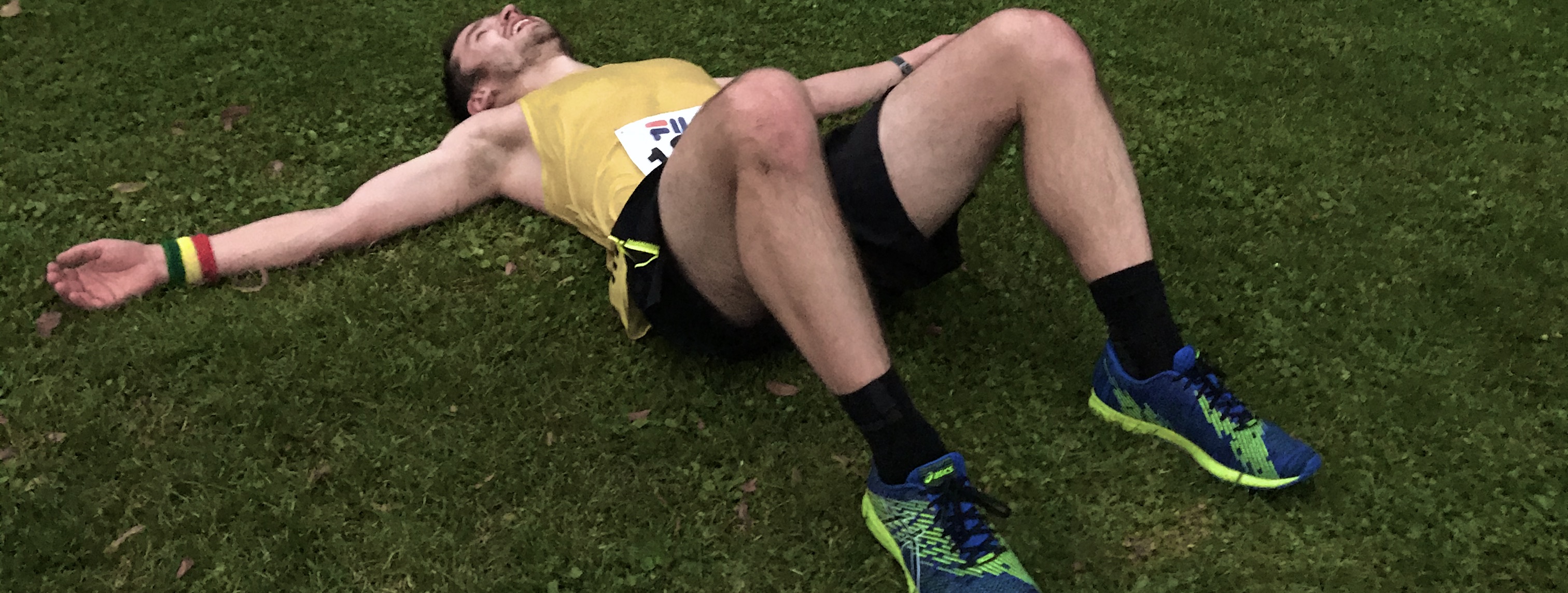Coping with injuries as a runner

I have chosen a rather depressing topic for my first blog post. But it is a topic that has stuck with me ever since I started taking running more seriously: injuries. Most types of physical activity bring with them a certain risk for injury. But as runners we have to deal with one issue in particular: pounding. At the 2019 Chicago Marathon, I made more than 30,000 steps according to my watch. In other words, 30,000 times I pushed my entire body weight off the ground with one leg and then landed with my entire body weight on the other leg. Doing this over and over again during a long build-up to your goal race inevitably takes its toll on your body. As a consequence, I have had to deal with injuries at least once, but often twice in every year since I started training for marathons.
Every time this happens I tell myself that I will do things differently from now on and every time I fall back into old habits once I'm fully recovered. Writing up my thoughts on this topic is my way to really reflect on how I can improve upon past mistakes. But I hope it will also inspire others and start conversations that help us all to deal with this aspect of running.
So without further ado, here are my top 4 rules for how to deal with or - even better - prevent injuries; the reasons why I have failed at each one of them in the past; and ideas how to tackle these failures. One cautionary remark: even though I'm in the final stages of finishing my doctorate, I'm not "that kind of doctor". None of what I write should be taken as medical advice. These are just my personal experiences.
Rule №1: If it hurts, stop doing what you're doing.
One would think this should be a no-brainer. Our brains are set up to make us stop any activity that leads to pain. As a matter of fact, the only purpose of pain is to let us know that something is wrong and that we are in danger of inflicting damage to our body. But runners are strange people. And in a way this most simple rule is also the most complicated one.
The problem(s):
There are two major reasons why one would ignore pain and keep going: First, as any ambitious distance runner knows, pain is part of the process. I can't even recall how many times friend have asked me whether I was injured when I was limping up (or down) the stairs and my reply was, "No, just did a 20 miler (or 10 times 1000 or 400s-till-failure) yesterday." Often it is not clear whether this uncomfortable feeling in you glut or knee or hamstring or calf is normal muscle soreness or the onset of a serious injury. And most runners go by the rule, "When in doubt, keep going."
Second, it can be very inconvenient to stop mid-run. My latest injury started during a 7.5 mile mid-tempo run on a dark and cold morning with a light drizzle. My glut started feeling weird about three quarters into the run. The idea of walking home those last 2 miles through the wet and cold morning was very unappealing, to say the least. Also, the pain didn't seem that bad, so I kept going. By the time I reached home, however, it had become a lot worse. And here I am, three weeks later, just barely able to run 4 miles and still not pain-free.
The solution(s):
The first issue is, unfortunately, one that does not have a good solution. Telling soreness from injury is tricky and requires a lot of experience. One general rule is that any sharp pain with a sudden onset is very likely an injury. But as my current case shows, it can also start with a very slight, nagging, uncomfortable feeling that slowly gets worse. The best advice I have is to replace the mantra "When in doubt, keep going" with "When in doubt, stop!". Many runners think of an unfinished run as a failure or a set-back, or as having missed their goal. But the simple truth is that running 80 miles per week and reaching the start line healthy always beats running 90 miles, but never making it to race day.
As for the second issue: There are a few simple tricks for when you have to interrupt a run while miles away from home: If possible, take a phone with you, so that you can call someone to pick you up; bring some change (and, in 2021, a mask) so that you can take public transport if need be; ask a friend to come along on the bike so that you at least have company (or someone who can get help); try to run a loop on which you are never really far from home. In general, imagine that you have to stop running when you are farthest from home and make sure that you can deal with that situation.
Rule №2: Don't deal with it alone.
Going through injury can be a very challenging experience, not only physically, but also mentally. Having someone to talk to can be immensely helpful. This can be someone you feel close to, such as a good friend or family member, someone who knows about running issues, such as a coach, or a medical professional, such as a physician or a physical therapist.
The problem:
Not being able to run because of an injury often feels like weakness and we humans are generally not good at admitting weakness. Admitting to your partner that you are in pain, or telling your coach that you can't complete your training this week is something that many runners don't feel comfortable with. With respect to medical professionals, my experience has often been that they don't offer much more than RICE (rest, ice, compression, elevation) for many of the typical running injuries.
The solution:
Recognize that other people are there to help you. Your partner, friends, or family can offer encouragement and maybe even take over some of your chores. If you have a coach, then one of the big advantages is that (s)he can flexibly adjust your schedule. One of the reasons why I started working with a personal coach is that I would always freak out when I was following a training schedule from the internet and then had to interrupt it due to injury. Nowadays, I simply tell my coach, "Hey, I can't run for 2 weeks", and then he will come up with a way for how I can still reach my goals.
As for seeking professional medical advice: even if you do get nothing more than a recommendation to take it easy for a few weeks, they typically rule out that it's something more serious. A specialist can often tell after a few simple tests whether it's an issue with your muscles, your bones, or your tendons. That doesn't speed up the recovery process but at least gives you some certainty that you will recover eventually.
Rule №3: Don't neglect the "extra stuff"
By "extra stuff" I mean all the things that we know we should do before and after running, but often don't do: proper warm-up, cool-down, stretching. I will not go down the road of how, when, and for how long you should do these things (at least not today), but there is no question that these things are useful.
The problem:
Most non-professional runners have to squeeze in their training somewhere between work, chores, family duties, and other things. Time is often limited and if you only have one hour, you want to spend as much as possible of that hour running, not doing things like stretching.
The solution:
My experience has been that even very little of the "extra stuff" can make a big difference. If you are focused, you can get a lot done in the 10 minutes before and after your run. I typically need some time to cool down between my run and taking a shower anyway, so that takes care of the "after". As for the "before": set your alarm clock 10 minutes earlier. 10 minutes less sleep won't do much harm (but more on sleep another time), but a 10 minute warm-up routine can go a long way in preventing injuries. My tip: define a sequence of exercises (e.g., I do 3 stretches with each leg for 30–40 seconds, for a total of 4–5 minutes) and stick to it for a few days. Then it will quickly become part of your daily routine.
Rule №4: Strength training
I think all of the injuries I have had to deal with could have been prevented by stronger muscles. Unfortunately, running itself does only little to strengthen all the muscles you need. My experience has been that weights are an essential tool for runners.
The problem:
While I do enjoy some forms of strength training, I hate pretty much all of the routines that are actually beneficial to runners. I think the four best and most essential exercises (for me) are: (half) squats, (hex bar) dead lifts, calf raises, and back extensions. The four exercises I like the least are: (half) squats, (hex bar) dead lifts, calf raises, and back extensions. The problem should be obvious.
The solution:
Tie the bad exercises to those exercises that you do like. You enjoy bench pressing? Reward yourself for doing squats by doing some bench pressing. You like curls? Learn to associate them with dead lifts. As with the "extra stuff", it's all about creating a routine that feels natural to you. Once you feel that curls are the natural thing to do after dead lifts, you won't feel so bad about the dead lift anymore.
For further ideas and inspirations in dealing with injuries, check out the Runfree training podcast by Ryan Hall (especially episodes 10, 11, 13, 65). Also, if you are looking for a coach, I can highly recommend their program.
Let me know what your experiences have been with injuries and how you deal with them. You can reach out to me via Instagram.
